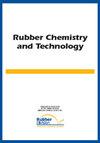深共晶溶剂预处理对废橡胶粉脱硫化的影响
IF 1.2
4区 工程技术
Q4 POLYMER SCIENCE
引用次数: 0
摘要
废橡胶的回收利用对环境保护非常重要,但相容性问题限制了废橡胶粉的回收和应用。实践证明,废橡胶粉(WRP)的脱硫化是提高增溶效果的有效方法。使用环保无毒溶剂不仅能提高脱硫效果,还能避免二次污染。因此,本文首先制备了一种环境友好型深共晶溶剂(DES),然后将其应用于水再生资源的脱硫化处理。结果表明,制备的 DES 具有积极的脱硫化效果,脱硫化率可达 50%。脱硫机理可分为两个方面。首先,吸附和去除含硫的低分子化合物。第二,破坏交联结构,改善流动性。微观结构观察表明,脱硫胶粉表面越粗糙,越有利于与基体材料发生交联反应,形成一个均匀的整体。DES 的脱硫化机理分为破坏含硫交联结构和吸附含硫低分子化合物两种。经 DES 处理后的 WRP 表面更加粗糙多孔,有利于与基体材料发生交联反应。最后,通过正交试验确定了脱交联效果的最佳工艺条件:液固比 15∶1、温度 120°C、时间 0.5 小时。本文章由计算机程序翻译,如有差异,请以英文原文为准。
Effect of Deep Eutectic Solvent Pretreatment on Devulcanization of Waste Rubber Powder
The recycling of waste rubber is very important for environmental protection, but the compatibility problem restricts the recycling and application of waste rubber powder. Devulcanization of waste rubber powder (WRP) has been proven to be an effective method to improve the solubilization effect. The use of environmentally friendly non-toxic solvents can not only improve the devulcanization effect, but also avoid secondary pollution. Thus, in this paper, an environmentally friendly deep eutectic solvent (DES) is first prepared, and then applied to the devulcanization treatment of WRP. The results show that the prepared DES has a positive devulcanization effect, and the devulcanization rate can reach 50%. The devulcanization mechanism can be divided into two aspects. Firstly, adsorption and removal of sulfur- containing low molecular compounds. Secondly, destruction of the crosslinking structure and improvement of the fluidity. The microstructure observation showed that the rougher the surface of the desulfurized rubber powder was, the more conducive to the crosslinking reaction with the matrix material to form a uniform whole. The devulcanization mechanism of DES is divided into destroying the sulfur-containing cross-linked structure and adsorbing the sulfur-containing low molecular compounds. The surface of WRP after DES treatment is rougher and more porous, which is beneficial to the cross-linking reaction with the matrix material. Finally, the optimum process conditions for the decrosslinking effect are determined by orthogonal test as follows: liquid-solid ratio 15∶1, temperature 120°C, time 0.5 h.
求助全文
通过发布文献求助,成功后即可免费获取论文全文。
去求助
来源期刊

Rubber Chemistry and Technology
工程技术-高分子科学
CiteScore
3.50
自引率
20.00%
发文量
21
审稿时长
3.6 months
期刊介绍:
The scope of RC&T covers:
-Chemistry and Properties-
Mechanics-
Materials Science-
Nanocomposites-
Biotechnology-
Rubber Recycling-
Green Technology-
Characterization and Simulation.
Published continuously since 1928, the journal provides the deepest archive of published research in the field. Rubber Chemistry & Technology is read by scientists and engineers in academia, industry and government.
 求助内容:
求助内容: 应助结果提醒方式:
应助结果提醒方式:


